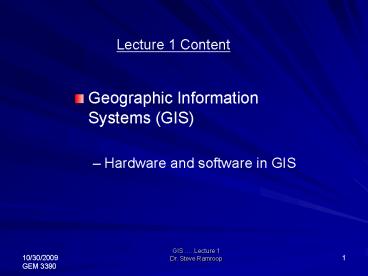GIS . Lecture 1 - PowerPoint PPT Presentation
1 / 15
Title:
GIS . Lecture 1
Description:
ranging from a stand-alone microcomputer to a large mainframe supporting many users ... bytes, Kbytes (K, Kb, 103 bytes), Megabytes (Mb, 106 bytes) Gigabytes (Gb, 109) ... – PowerPoint PPT presentation
Number of Views:245
Avg rating:3.0/5.0
Title: GIS . Lecture 1
1
Lecture 1 Content
- Geographic Information Systems (GIS)
- Hardware and software in GIS
2
(No Transcript)
3
- 1.0 Introduction
- the environment in which a GIS operates is
defined by - Hardware
- i.e. the machinery
- includes the
- ranging from a stand-alone microcomputer to a
large mainframe supporting many users - several devices for handling machinery input and
output - Software
- the programs that tell the computer what to do
- the data the programs will use
4
- Understanding Computer Data
- computer data is coded, manipulated and stored by
use of an exclusive two-state condition - in English such two-state forms of information
can include - 1/0, yes/no, on/off, open/close, hole/nohole
- note that one of the two exclusive states always
exist
5
- computer files which contain information coded in
ASCII are easily transferred and processed by
different computers and programs - such files are often called ASCII of text or
coded files - ASCII characters are the dominant basis for
communication between different systems, and
communications with peripherals - files which are not ASCII are often coded in
binary and generally can be processed or
understood only by specific programs
6
- Computer Hardware
- Computers consist of several different hardware
components - Central Processing Unit (CPU)
- the central processing unit is the essential
component of a computer because it is the part
that executes the programs and controls the
operation of all the hardware
7
- Powerful computers may have several processors
handling different tasks, although there will be
need to be one central processing unit
controlling the flow of instructions and data
through the subsidiary processors - the CPUs of PCs are based on a series of
processors or chips from Intel - Development in models use the 8 bit, 16 bit, 32
bit, 64 bit, and such like - the Macintosh CPUs are based on a series of
chips from Motorola
8
- Memory
- the memory stores input for and output from the
CPU as well as the instructions that are followed
by the CPU - the amount stored is measured in bits, bytes,
Kbytes (K, Kb, 103 bytes), Megabytes (Mb, 106
bytes) Gigabytes (Gb, 109), Terabytes (Tb, 1012)
9
- There are three kinds of memory
- Main Memory
- also called internal or primary memory
- it is essential for the operation of the
computer, all data and instructions must be in
main memory first before it can be processed by
the computer - most costly memory
- in the form of microchips integrated with the
computers central processor - fastest access - any byte can be accessed equally
rapidly (random access, hence it is called RAM)
10
- Temporary Memory
- since data and instructions are stored in main
memory as electrical voltages, power failures
cause loss of all data in main memory - ranges from several hundred Kbytes for a typical
PC to many gigabytes for mainframes - Secondary Memory
- used for large permanent or semi-permanent files
- GIS programs and data generally require very
large amounts of storage
11
(No Transcript)
12
(No Transcript)
13
- Peripherals
- refer to all the other devices attached to
computers that handle input and output - input devices include keyboards, mice,
trackballs, digitizers, disk drives - output devices include screens, printers, plotters
14
(No Transcript)
15
- The End































